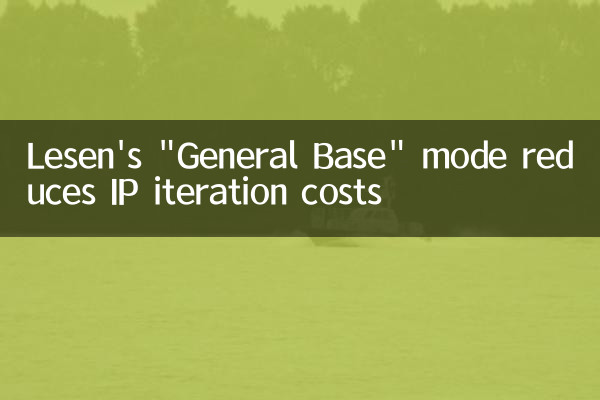Lesen's "General Base" model reduces IP iteration costs: a new breakthrough in the intelligent robot industry
In recent years, the intelligent robot industry has developed rapidly, and the iteration and innovation of IP (intellectual property rights) have become the core of corporate competition. However, high R&D costs and long iteration cycles have always been the pain points of the industry. The "universal base" model proposed by Lesen Robot provides new ideas for solving this problem. This article will combine popular topics and structured data on the entire network in the past 10 days to analyze how Lesen can reduce the cost of IP iteration through this model.
1. Hot topics and industry trends across the network

In the past 10 days, topics such as intelligent robots, AI technology, and IP commercialization have attracted much attention. The following is a compilation of some hot content:
| Hot Topics | Discussion hot topic | Related companies |
|---|---|---|
| Cost optimization of intelligent robots | high | Lesen, UBL, Boston Power |
| AI technology empowers IP development | Medium-high | OpenAI, DeepMind |
| New model of IP commercialization | middle | Disney, Tencent, Lesson |
It can be seen from the table that cost optimization of intelligent robots is one of the core issues in the current industry, and Lesen's "general base" model hits this demand.
2. The core advantages of Lesen’s “General Base” model
Lesen's "universal base" model greatly reduces the cost and time of IP iteration by standardizing the underlying hardware and modular design. The following is a detailed analysis of its core advantages:
| Advantages | Specific performance | Cost reduction |
|---|---|---|
| Hardware standardization | General purpose chassis, sensors, power system | 30%-40% |
| Software modularity | Reusable algorithms, open API interfaces | 20%-30% |
| Quick iteration | IP development cycle is shortened by 50% | Reduce labor costs by 25% |
From the above data, we can see that Lesen's "general base" model has achieved significant cost optimization in hardware, software and development efficiency.
III. Industry case analysis
Lesen's model has been verified in several projects. For example, its deformation robot project, which cooperates with well-known animation IP, shortened the development cycle from 12 months to 6 months through the "universal base" model, while reducing R&D costs by 35%. The following is a comparison of specific data:
| project | Traditional model (cost/cycle) | Universal base mode (cost/cycle) |
|---|---|---|
| Anime IP Robot A | 5 million yuan/12 months | 3.25 million yuan/6 months |
| Game IP Robot B | 4.5 million yuan/10 months | 3 million yuan/5 months |
This model not only applies to Lesen itself, but also provides industry partners with reusable solutions.
4. Future prospects
As the intelligent robot market continues to expand, the demand for IP iteration will continue to grow. Lesen’s “general base” model is expected to become an industry standard, promoting more companies to achieve low-cost and high-efficiency IP development. In the future, Lesen plans to open this platform and cooperate with more IP parties to jointly explore the commercialization path of intelligent robots.
In short, Lesen's "universal base" model is an important innovation in the intelligent robot industry, providing a practical solution to reduce the cost of IP iteration. The success of this model may lead the industry to a more efficient and sustainable development direction.

check the details

check the details